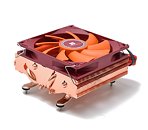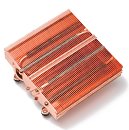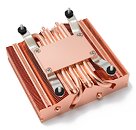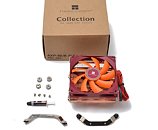Monday, November 11th 2019
Thermalright Rolls Out AXP-90 Full Copper CPU Cooler
Thermalright rolled out the AXP-90 Full Copper top-flow CPU cooler for low-profile PC builds. A smaller sibling of the AXP-100 Full Copper, and a variant of the aluminium-based original AXP-90, this cooler features a dense copper fin-stack that's arranged along the plane of the motherboard. Four 6 mm-thick copper heat pipes make indirect contact with the CPU over a mirror-finish copper base-plate, pulling heat through the fin-stack. A 15 mm-thick 92 mm TL-9015R fan ventilates the fin-stack. This fan takes in 4-pin PWM input, spins at speeds of up to 2,700 RPM, pushing up to 42.58 CFM of air, with as low as 22.4 dBA of noise output. With the fan in place, the AXP-90 Full Copper measures 97 mm x 92 mm x 47 mm (WxDxH), weighing 490 g. There are two sub-variants of the cooler specific to CPU socket type supported, the AXP-90 Full Copper LGA115X, and AXP-90 Full Copper AM4. Available on Chinese e-tailers such as T-Mall, the AXP-90 Full Copper is priced at RMB 299, or the equivalent of USD $42.70.




41 Comments on Thermalright Rolls Out AXP-90 Full Copper CPU Cooler
on topic, sexy af, reminds me of the Scythe anniversary cooler way back when.
As much as those fins like transferring heat, they also really like holding onto it.
I love Tr coolers - before I switched to LC, always used their stuff, from SLK-947 up 'till HR-01 Plus. For me this brand, along with Noctua, was always a synonym of high quality
Heat transfer coefficient is dependent on material its shape, surface and surrounding medium, how well can heat get to the environment.
Heat capacity is a material property and not important in steady state.
To cool something, heat must get from the source through the cooler to surrounding medium, air (which itself is a good insulator). If the only change in cooler is Al to Cu fins, it means the heat can better spread through the fins only, but not into the air around them. Higher heat capacity means the heatsink will warm up later, but also stay warmer longer. That's because air is the limiting factor and Al is sufficient for relatively low temperature, low heat flux individual heatsink fins.
Also, specific volumetric heat capacity of Cu is ~42% higher than Al. This means a heatsink of the same shape made of Cu is ~230% heavier, but can store only 42% more energy than Al one. If Al heatsink warms up fast, Cu one will heat up only slightly less fast. It looks nice, feels heavy, but it's not that different when cooling with air.
In a small design like this, the weight is less of an issue than it is for a huge tower cooler, so I imagine there will be a number of people who are more than willing to trade their Alu coolers for this, and gain that small performance advantage and aesthetic boon.
There used to be a bunch of voodoo people would spout about aluminium having better "emissivity", and therefore somehow being better. That's complete rubbish and you should ignore anyone spouting it.
The explanation I've always found made the most sense is this one:
If you could magically somehow heat one copper heatsink fin and one alu heatsink fin to exactly the same temperature, say 40C, in an ambient of 21C, and you blew a fan on them, the amount of heat moved off of each fin would be identical. The material used simply doesn't matter in that way. Each molecule of 21C air would pass over something 40C, pick up the same amount of heat while doing so, and then blow away into the room.
Thing is, heatsinks are not heated evenly across their whole surface like that. You can't just poke a heatpipe through a piece of metal and expect it to heat that metal evenly across it's entire surface. The heat will conduct outward from that central point and so the area next to the heatpipe will be hotter than the ends of the fins.
The longer you make the fins, the further it has to be conducted away from that heatpipe. After a certain distance, adding extra length to a fin makes no difference, because the heat simply never gets there before it's dissipated by airflow. You can increase that distance by using a material that conducts heat more quickly along it's length - like copper.
Additionally, if you do this, then the distribution of heat along that fin ends up being more even. By this principle, an all-copper heatsink can have longer fins before that impacts performance.
The greater the delta between ambient temperature, and the temperature of a dissipating element, the faster the transfer of heat between that element and the air moving across it. Since the Cu heatsink will have a greater delta over a greater portion of the fin, it therefore acts similarly to as if the heatsink had more surface area - but, and this is the big but - this is only really a relevant factor if the fin is long enough to start with, that it would have noticably uneven heat distribution due to the difference in conductivity.
For this reason, at least when the medium of heat transfer from the IHS is a heatpipe, large all-copper heatsinks do perform slightly better than large Copper/Alu heatsinks, but small heatsinks will show a smaller difference in performance between these two approaches.